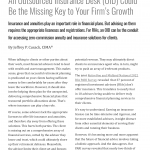What is sequence of returns risk, and why is it so important to understand during this bear market? In a March 2020 article for Barron’s, journalist Neal Templin explores the impact this risk may have on retirees and near-retirees.
Templin also describes some potential actions investors may take to minimize the potential negative consequences a poor sequence of returns may have on investment portfolios during the “fragile decade“—the five-year period just before and through the first five years of retirement.
The issue for many American savers right now is that they are suffering a bull market during a time of depressed interest rates, poor fixed income yields, and what have been relatively high stock valuations. The outlook is a little cloudy for boomers looking to slap a gold watch on their wrists and hit the links right now.
With updated market data Dr. Wade Pfau of the American College recently calculated the safe withdrawal rate to be nearly half the rate William Bengen famously articulated in 1994. Pfau says that number is now closer to 2.4%.
Creating sustainable income streams that will also meet retiree spending needs in this environment is difficult, but not impossible. Delaying social security, of course, is the first recommendation Templin offers. Bill Bernstein, Author of Investor’s Manifesto: Preparing for Prosperity, Armageddon, and Everything in Between calls social security “the world’s best annuity.”
Templin also shares his own research into private annuities—immediate and deferred variable annuities—each offering their own distinct advantages. As RetireOne CEO David Stone points out, the cost of variable annuities with guaranteed living withdrawal benefits should be a consideration. Next-gen, no-load variable annuities on the market today are lower cost and offer considerably more client value than their traditional counterparts.
Creating an income floor using an annuity can then give investors the confidence to take on more risk as they age into retirement. Michael Kitces and Dr. Pfau both espouse a “rising equity glide path” that allows retirees to spend down retirement assets with a greater safety margin.



